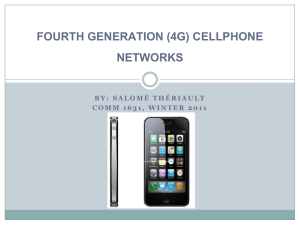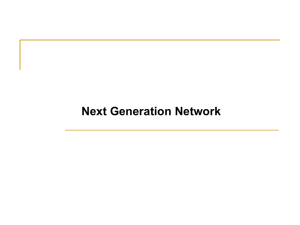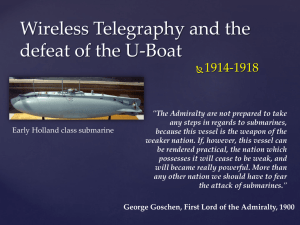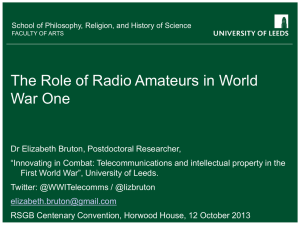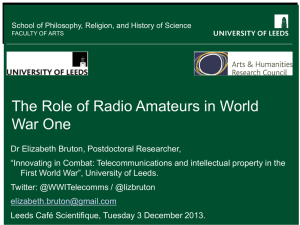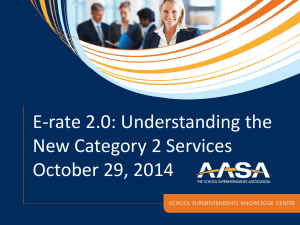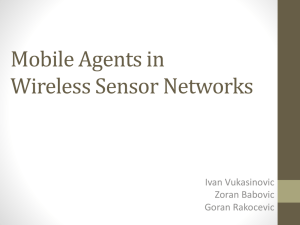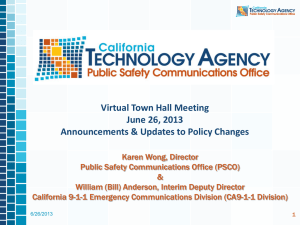ppt - Zoo
advertisement
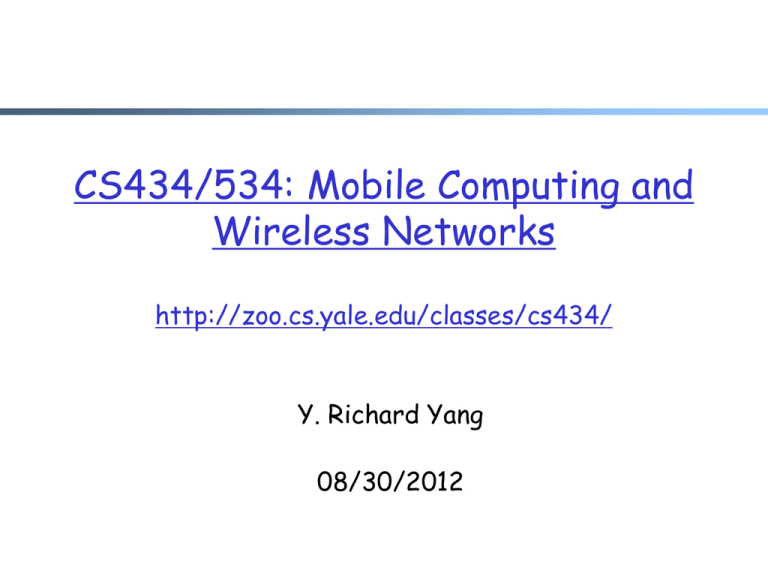
CS434/534: Mobile Computing and Wireless Networks http://zoo.cs.yale.edu/classes/cs434/ Y. Richard Yang 08/30/2012 Outline Pervasive wireless networks and mobile applications Challenges facing wireless networks and mobile computing Course information 2 Goal of Mobile Computing “People and their machines should be able to access information and communicate with each other easily and securely, in any medium or combination of media – voice, data, image, video, or multimedia – any time, anywhere, in a timely, cost-effective way.” Dr. G. H. Heilmeier, Oct 1992 3 Pervasive Mobile Devices “In many parts of the world, more people have access to a mobile [wireless] device than to a toilet or running water.” [Time Aug. 2012] Many industrial countries reach at least 90% mobile phone subscription penetration rate [see phone penetration rates sheet] PEW Internet and American Life Project: “The mobile device will be the primary connection tool to the Internet for most people in the world in 2020” 4 Pervasive Wireless Networks Wireless coverage: http://www.verizonwireless.com/wireless -coverage-area-map.shtml http://www.wireless.att.com/coveragevie wer/ 5 Mobile Device Usage Source: O2 6 Mobile Traffic Growth Source: Cisco 7 Mobile Computing Changing Our Lives Source: TIME mobility survey; June-July 2012 8 10 Use Cases of Mobile Computing Changing the World Source: TIME survey; June-July 2012 9 Mobile Computing Features with Larger Effects Source: TIME survey; June-July 2012 10 Mobile Computing Changing Our Lives Source: TIME survey; June-July 2012 11 Mobile Computing Changing Our Lives Source: TIME survey; June-July 2012 12 Mobile Computing Changing Our Lives Source: TIME survey; June-July 2012 http://www.time.com/time/interactive/0,31813,2122187,00.html 13 Use Case: Home Networks satellite WiFi 802.11g/n WiFi WiFi Bluetooth NFC UWB bluetooth WiFi cellular 14 Use Case: Mesh Networks Many users still don’t have broadband reasons: out of service area; some consider expensive 15 Use Case: Mesh Network for Disaster Recovery/Military 9/11, Tsunami, Hurricane Katrina, South Asian earthquake … Wireless communication and mobile computing capability can make a difference between life and death ! http://www.att.com/ndr/ rapid deployment efficient resource and energy usage flexible: unicast, broadcast, multicast, anycast resilient: survive in unfavorable and untrusted environments 16 Use Case: Seamless Handoff--Always Best Connected LAN, WLAN 780 kbit/s GSM 53 kbit/s Bluetooth 500 kbit/s UMTS Rel. 5 400 kbit/s LAN 100 Mbit/s, WLAN 54 Mbit/s UMTS, DECT 2 Mbit/s GSM/EDGE 135 kbit/s, WLAN 780 kbit/s GSM 115 kbit/s, WLAN 11 Mbit/s UMTS Rel. 6 400 kbit/s 17 Use Case: Traffic Signal Advisor http://www.princeton.edu/~ekoukoum/SignalGuru.html 18 Use Case: Vehicular Networks Traffic crashes resulted in more than 41,000 lives lost/year Establishing vehicle-to-vehicle (V2V), vehicle-to-infrastructure (V2I) and vehicle-to-hand-helddevices (V2D) communications More info: http://www.its.dot.gov/intellidrive/index.htm 19 Collision Avoidance : V2V Networks stalled vehicle warning bland spots http://www.gm.com/company/gmability/safety/news_issues/releases/sixthsense_102405.html 20 Collision Avoidance at Intersections Two million accidents at intersections per year in US Source: http://www.fhwa.dot.gov/tfhrc/safety/pubs/its/ruralitsandrd/tb-intercollision.pdf 21 Google Glass 22 Use Case: Habitat Monitoring A 15-minute human visit leads to 20% offspring mortality Patch Network Gateway Transit Network Basestation 23 Wireless and Mobile Computing Driven by technology and vision Mobile device capabilities and platforms Global communication infrastructures The field is moving fast 24 Enabling Infrastructures Development and deployment of wireless infrastructures networking: in-room, in-building, on-campus, in-thefield, MAN, WAN Development and deployment of localization infrastructures location: GPS, AGPS, … Development and deployment of sensor networks 25 Wireless Bit Rates 1.2 kbps 9.6 kbps 384 kbps 2 Mbps 100 Mbps 1 Gbps NMT 1981 GSM 1992 IMT-2000 2001 (WCDMA; CDMA) IMT-Advanced ~2012 26 Enabling Infrastructure: Networks Standard GSM GPRS Class 10 GSM EDGE Evolution CDMA EV-DO Rev. 0 CDMA EV-DO Rev. A CDMA EV-DO Rev. B WiFi: 802.11b Flash-OFDM: Flash-OFDM WiFi: 802.11g WiFi: 802.11a LTE WiMAX: 802.16m WiFi: 802.11n HSPA+ LTE Advanced (Cat 8) WiFi: 802.11ac (8aAP; 4a ST) All units are Mbps Peak Downlink Peak Uplink Tech 0.0856 0.0428 1.6 0.5 TDMA/FDD 2.458 0.1536 CDMA/FDD 3.1 1.8 CDMA/FDD 4.9 1.8 CDMA/FDD 11 11 DSSS 15.9 5.4 Flash-OFDM 54 54 OFDM 54 54 OFDM 300 75 OFDMA/MIMO 365 376 MIMO/SOFDMA 600 600 OFDM/MIMO 672 2998.6 3470 168 CDMA/FDD/MIMO 1497.8 MIMO 3470 MU-MIMO 27 Enabling Infrastructure: Measurements Source: A Close Examination of Performance and Power Characteristics of 4G LTE; Mobisys’12 28 Improving Infrastructure: Power Efficiency Source: A Close Examination of Performance and Power Characteristics of 4G LTE; Mobisys’12 29 Enabling Device Capabilities, Platforms Improving device capabilities, mobile application frameworks, applications, e.g., andriod iphone/ipad windows phone 30 Processing Capability: Javascript Benchmark 31 Processing Capability: Javascript Benchmark 32 Processing Capability: Javascript Benchmark 33 Processing Capability: Javascript Benchmark 34 Processing Capability: Javascript Benchmark 35 Processing Capability: Javascript Benchmark 36 Processing Capability: Javascript Benchmark 37 Sensing Capability (iphone 4) 38 Why is the Field Challenging? Challenge 1: Unreliable and Unpredictable Wireless Coverage Wireless links are not reliable: they may vary over time and space Reception v. Distance Reception vs. Power *Cerpa, Busek et. al What Robert Poor (Ember) calls “The good, the bad and the ugly” 40 Challenge 2: Open Wireless Medium Wireless interference S1 R1 S2 R1 41 Challenge 2: Open Wireless Medium Wireless interference S1 R1 S2 R1 Hidden terminals S1 R1 S2 42 Challenge 2: Open Wireless Medium Wireless interference S1 R1 S2 R1 Hidden terminals S1 R1 S2 Exposed terminal R1 S1 S2 R2 43 Challenge 2: Open Wireless Medium Wireless interference S1 R1 S2 R1 Hidden terminals S1 R1 R2 Exposed terminal R1 S1 Wireless security S2 R2 eavesdropping, denial of service, … 44 Challenge 3: Mobility Mobility causes poor-quality wireless links Mobility causes intermittent connection under intermittent connected networks, traditional routing, TCP, applications all break Mobility changes context, e.g., location 45 Challenge 4: Portability Limited battery power Limited processing, display and storage Sensors, embedded controllers Smart phone • data • smaller graphical displays • 802.11/3G Tablet/Laptop Mobile phones • voice, data • simple graphical displays • GSM/3G/4G Performance/Weight/Power Consumption 46 Challenge 5: Changing Regulation and Multiple Communication Standards 47 Challenge 5: Changing Regulation and Multiple Communication Standards cellular phones 1981: NMT 450 satellites 1986: NMT 900 1992: GSM 1994: DCS 1800 analogue 1984: CT1 1988: InmarsatC 1991: 1991: CDMA D-AMPS 1993: PDC 2000: GPRS wireless LAN 1980: CT0 1982: InmarsatA 1983: AMPS cordless phones 1992: Inmarsat-B Inmarsat-M 1987: CT1+ 1989: CT 2 1991: DECT 1998: Iridium 199x: proprietary 1997: IEEE 802.11 1999: 802.11b, Bluetooth 2000: IEEE 802.11a 2001: IMT-2000 digital Fourth Generation (Internet based) 48 Wireless Communication Standards 49 What Will We Cover? Class Info: Personnel Instructor • Y. Richard Yang, yry@cs.yale.edu, AKW 308A • office hours: to be posted • Ramki Gummadi, ramki@cs.yale.edu, AKW 413 Teaching fellow • To be posted • office hours: to be posted on class page Course home page http://zoo.cs.yale.edu/classes/cs434/ 51 Class Goals Learn both fundamentals and applications of wireless networking and mobile computing Obtain hands-on experiences on developing on wireless, mobile devices wireless networking: GNU radio mobile computing: Android (you may explore IOS or Windows Mobile in your project) Discuss challenges and opportunities in wireless networking and mobile computing 52 The Layered Reference Model Application Application Transport Transport Network Network Data Link Physical Radio Network Network Data Link Data Link Data Link Physical Physical Physical Medium Often we need to implement a function across multiple layers. 53 Course Topic: Communications/Connectivity Physical layer: channel and diversity Link layer: channel sharing Network and transport: routing, reliability 54 Course Topic: Mobile OS/App Framework Android app framework Activity, service, intent, content provider, handler/AsyncTask, … Virtualizing mobile OS Measuring/profiling mobile app Why are web browser slow on smartphones? Why did some small percentage of Pandora’s traffic is responsible for a large fraction of energy use on my phone? … 55 Course Topic: Mobile Network App Techniques Informed usage of networks MatchMaking Using peer-to-peer connections Wifi Direct, Microcast, NFC Hybrid mobile/cloud/server Cloud messaging Code partition (MAUI, Cloudlet) Aggregation (SmartVNC) Storage partition 56 Course Topic: Sensory Framework/App Location Localization (GPS, lateration, acoustic, siganture) Location based services • Google MapView, Map API Sensing Detecting the environment using cameras, microphones, and collaborations • signalGuru, Darwin Phone 57 Course Topics OS/Application Platform Communications Sensing Security (will not cover) 58 Class Materials Chapters of reference books Selected conference and journal papers Other resources MOBICOM, SIGCOMM, Mobisys proceedings IEEE Network, Communications, Pervasive magazines 59 Suggested Reference Books “Fundamentals of Wireless Communication”, by David Tse and Pramod Viswanath, Cambridge University Press (available online) “802.11 Wireless Networks: the Definitive Guide” by Matthew Gast, O’Reilly (available online) 60 Suggested Reference Books (2) “The Android Developer’s Cookbook”, by James Steele and Nelson To “Hello, Android”, by Ed Burnette Developer guide: http://developer.android.com/guide/components/index.html 61 What You Need to Do Your prerequisite motivated, critical basic programming skill • • Gnuradio: GUI, python, C++ Android: Java, C (if you decide to hack into the kernel) Your workload class participation • actively participate in class discussions 3-4 assignments One project One midterm 62 Class Project Goal: obtain hands-on experience We’ll suggest potential topics You may also choose your own topic Initial proposal + midterm progress report + final report + [presentation] We provide help in obtaining Mobile devices Amazon/Google cloud service accounts 63 Grading Project 35% Assignments 35% Exam 20% Class Participation 10% More important is what you realize/learn than the grades 64 Class Survey Please take the class survey help me to determine your background help me to determine the depth and topics suggest topics that you want to be covered 65 Questions? Backup 67 Evolution of Mobile Systems to 3G 68 3G Networks http://en.wikipedia.org/wiki/List_of_mobile_network_operators_of_the_Americas#United_States 69 Mobile Computing Changing Our Lives Source: TIME survey 70 IMT Advanced Requirements All-IP communications. Peak data rates 100 Mbit/s for high mobility 1 Gbit/s for low mobility Scalable channel bandwidth, between 5 and 20 MHz, optionally up to 40 MHz Peak link spectral efficiency 15 bit/s/Hz (downlink); 6.75 bit/s/Hz (uplink) System spectral efficiency 3 bit/s/Hz/cell (downlink) 2.25 bit/s/Hz/cell (indoor) 71
